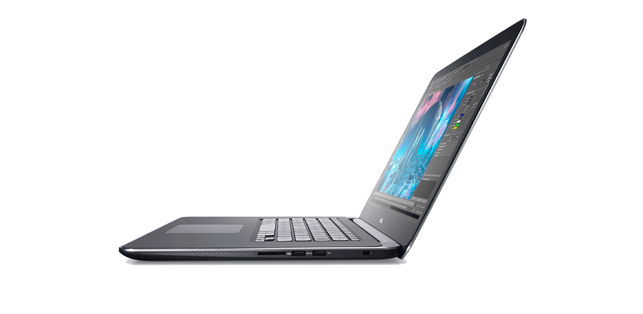The problem with most mobile workstations is that they’re not particularly mobile. Most 15-inch models weigh injust under 3kg; 17-inch models even more.

Dell Precision M3800
While this might not sound like a lot, try carrying half a dozen baked bean cans around for the day and you’ll soon get the idea.
Dell’s new Precision M3800 is specifically designed to deliver workstation-class components in a lightweight package. This has been attempted before but has often been at the expense of screen size and graphics performance (remember the 14-inch Dell Precision M2400?).
With Dell’s latest offering there are no such compromises: the Precision M3800 is an entirely new class of mobile workstation. It sports an expansive 15.6-inch screen but it still feels incredibly light in the hand.
Starting at 1.88kg it weighs less than a 13-inch MacBook Pro, from which it arguably takes many of its styling cues. And while its aluminium frame and lightweight carbon fibre base is not quite in the same league as the unibody aluminium chassis of the MacBook pro, it does feel refined and well built.
But this is a bit like comparing apples with pears, for want of a better analogy. The MacBook Pro may be a great all-round laptop, but the Dell Precision M3800 is an entirely different beast; a proper 3D CAD mobile workstation, certified for a huge range of applications including Inventor, Catia, SolidWorks, Creo, and NX.
Inside, Dell is very prescriptive with the core specifications and all models share the same CPU and GPU. This is quite unusual for a laptop and partly down to the strict thermal limits dictated by the compact chassis.
Rated at 37W and 45W respectively the Intel Core i7-4702HQ CPU and Nvidia Quadro K1100M GPU are pretty easy on power consumption and together they offer a good balance of performance, ideally suited to entry-level to mid-range 3D CAD.
Both have dedicated fans to help minimize throttling when the processors really start to heat up.
The Intel Core i7-4702HQ is not the fastest ‘Haswell’ CPU out there — the Intel Core i7-4900MQ, available in the Dell Precision M4800, is a full 0.6GHz faster — but with a base clock speed of 2.2GHz (3.2GHz Turbo) it’s still a good spec for mainstream CAD.
With four cores and eight threads there’s also power in reserve for rendering and simulation — though with a maximum of 16GB RAM datasets can’t get too big.
For graphics the Quadro K1100M is at the lower end of Nvidia’s Kepler family of mobile GPUs.
Experience suggests that this 2GB GPU should be sufficient for part and small assembly modelling but may start to show its limitations as models get larger, particularly when using real time effects such as SolidWorks RealView.
The choice of core specs may be limited, but the M3800 certainly makes up for this when it comes to storage. Users have a number of options for the main 2.5-inch drive including a Hard Disk Drive (HDD) (up to 1TB); Solid State Hybrid Hard Drive (SSHD) (500GB with 8GB SSD); or Solid State Drive (SSD) (256GB or 512GB).
There’s also room for Solid State Mini-Card storage device (mSATA) (up to 512GB), which gives users a cost effective way to get performance and capacity in the one machine. Here, a 128GB mini-card could be used for OS and apps while a 1TB HDD is reserved for data.
The Precision M3800 comes with a choice of two Gorilla Glass FHD or QHD+ UltraSharp displays.
Detailed CAD models on our test machine’s QHD+ display (3,200 x 1,800) certainly looked stunning with crisp lines and vibrant colours. However, with such a high pixel density we did find some of the icons were too small, even with the Windows settings ramped up.
With nearly three times as many pixels as the standard FHD display ((1,920 x 1,080) we would also expect the QHD+ screen to have a small but significant impact on 3D performance. Choosing a display needs careful consideration.
Both displays feature 5-finger multitouch as standard, which will have the greatest appeal to users of Windows 8. For more traditional input the gesture enabled multi-touch touchpad is of a good size, which makes it useful for CAD.
Of course, for detailed work there’s no substitute for an external mouse, which can plug into one of the four USB ports (3 x USB 3.0 and 1 x USB 2.0). All four ports feature PowerShare, which is great for charging SmartPhones and other devices as the power remains on even when the machine is off.
In conclusion, the Precision M3800 looks to be an interesting proposition for those seeking workstation-class performance and impressive portability without compromising on screen size.
Some may find the specs restrictive — and if you want to beef up the CPU, GPU and memory then look at the Precision M4800 — but if you’re looking for a highly mobile machine for part and small assembly modelling then the M3800 should hit the spot.
We look forward to putting it through its paces in the New Year.
The HP ZBook 14
With Dell concentrating on re-defining the 15-inch format factor mobile workstation, HP is going all out on portability with its ZBook 14, which it describes as the world’s first workstation Ultrabook.

This lightweight 14-inch mobile workstation starts at an incredible 1.62kg, just 300g more than the 13-inch MacBook Air.
The machine comes with a choice of dual core processors, maxing out at the Intel Core i7-4600U (2.1GHz, turbo up to 3.3GHz) and up to 16GB RAM.
Professional 3D graphics comes courtesy of the AMD FirePro M4100 (1GB). All of these specs lean the machine towards entry-level 3D CAD.
HP also places a big emphasis on serviceability with many of the components being able to be replaced or upgraded without a screwdriver.






